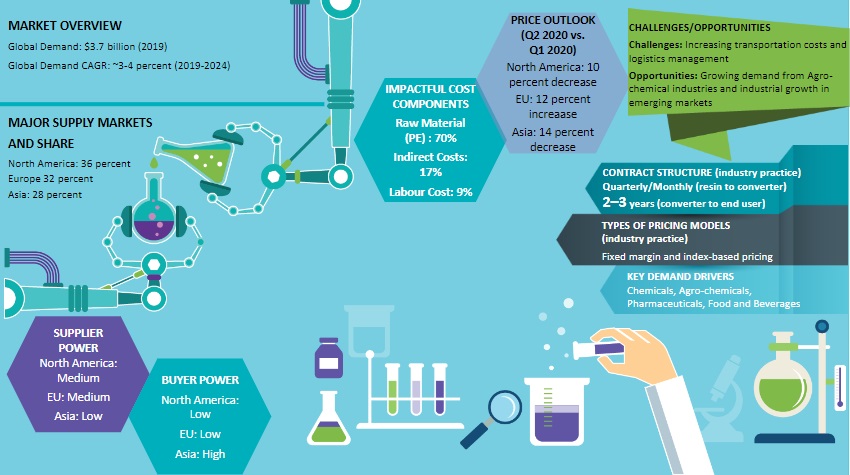CATEGORY
Rigid Intermediate Bulk Containers (RIBC)
IBC market demand and product trends are covered across 4 regions.
Beroe LiVE.Ai™
AI-powered self-service platform for all your sourcing decision needs across 1,200+ categories like Rigid Intermediate Bulk Containers (RIBC).
Market Data, Sourcing & Supplier Intelligence, and Price & Cost Benchmarking.
Schedule a DemoCategory Alerts
Schutz to invest in its Missouri plant to produce IBC inner bottles.
March 07, 2023Greif has acquired Centurian Container LLC in North America
April 05, 2023Mauser Packaging expanded its product range
January 31, 2023Become a Beroe LiVE.Ai™ Subscriber to receive proactive alerts on Rigid Intermediate Bulk Containers (RIBC)
Schedule a DemoRigid Intermediate Bulk Containers (RIBC) Industry Benchmarks
Savings Achieved
(in %)
The average annual savings achieved in Rigid Intermediate Bulk Containers (RIBC) category is 5.40%
Payment Terms
(in days)
The industry average payment terms in Rigid Intermediate Bulk Containers (RIBC) category for the current quarter is 120.0 days
Compare your category performance against peers and industry benchmarks across 20+ parameters on Beroe LiVE.Ai™
Category Strategy and Flexibility
Engagement Model
Supply Assurance
Sourcing Process
Supplier Type
Pricing Model
Contract Length
SLAs/KPIs
Lead Time
Supplier Diversity
Targeted Savings
Risk Mitigation
Financial Risk
Sanctions
AMEs
Geopolitical Risk
Cost Optimization
Price per Unit Competitiveness
Specification Leanness
Minimum Order Quality
Payment Terms
Inventory Control
The World’s first Digital Market Analyst
Abi, the AI-powered digital assistant brings together data, insights, and intelligence for faster answers to sourcing questions
Abi is now supercharged with GPT4 AI engine. Enjoy the ease of ChatGPT, now on Abi

Use the Rigid Intermediate Bulk Containers (RIBC) market, supplier and price information for category strategy creation and Quaterly Business Reviews (QRBs)
Schedule a DemoRigid Intermediate Bulk Containers (RIBC) market report transcript
Global Market Outlook on Rigid Intermediate Bulk Containers (RIBC)
-
The global market for RIBCs was valued at $17.6 billion in 2023 and is expected to grow at the rate of 5–6 percent until 2027. RIBCs contribute to approximately 13 percent of the global bulk packaging demand. The overall demand is expected to continue to increase, owing to a market recovery in key downstream segments, such as industrial and agro-chemicals, construction, and growing demand from the pharma sector.

Demand Market Outlook –RIBC
-
Chemicals, agrochemicals, petrochemicals, and pharmaceutical industries are the major end-use segments, driving the demand for industrial RIBCs. The APAC and LATAM are witnessing the highest growth rates of around 4–5 percent and 5–6 percent, respectively. Increased safety measures are taken across the regions for transportation of product through rigid containers.
Global Market Outlook –Rigid Bulk Packaging
Market Growth and Drivers
-
The global bulk packaging market is expected to grow at a CAGR of 5–6 percent from 2023 to reach $21.8 billion in 2027. The market is expected to foster growth, mainly due to the increasing demand from chemical, petrochemical, pharmaceutical, and crop science industries, which rely on rigid bulk containers for packaging their products. The impact of COVID will be nil on the RIBC industry
Rigid Bulk Packaging Types
-
IBCs are one of the predominantly used packaging types in rigid bulk packaging, due to their high storage capacity
-
Other packaging formats, such as drums, bulk boxes, and material handling containers are also expected to foster growth, due to the advantages it offers over other packaging types, such as storage and handling efficiency, greater reusability, and emphasis on sustainability, and closed-loop supply chains
Global Demand Analysis – RIBC
-
The RIBC market is expected to grow at a CAGR of 5–6 percent to reach $21.8 billion in 2027. The market is likely to foster the growth, due to increasing demand from major end-users, like chemical, petrochemical, and pharmaceuticals
-
Globally, the IBC industry has an average utilization rate of 65 percent, and the manufacturers are able to meet the demand without any supply constraints
Global Market Demand (2023–2027F)
-
The RIBCs market is expected to grow fast, due to the resurgence of chemical production. Chemicals accounted for more than 65 percent of the RIBCs demand, globally. The upswing in the production of durable goods is another growth driver of RIBCs
-
RIBCs contribute to 12 percent of rigid bulk packaging demand and would experience strong growth in the next five years, owing to their long-term cost and performance advantages. The regulations for the transportation of hazardous goods, ensure high demand for RIBCs
-
The market is matured in the developed regions of North America and Europe. However, APAC might experience high growth for IBCs, owing to high-capacity additions from pharmaceuticals and chemicals
Global Demand by Application : RIBC
There has been consistent supply of RIBCs meeting the demand from major end-users, such as chemicals, food & beverage, petroleum, and hazardous waste. Chemicals contribute to 67 percent of the RIBCs demand, which may be shifted to pharmaceuticals and food industry
Downstream Demand Outlook
-
Chemicals occupy majority of RIBC demand. This increase is due to the resurgence of production in many regions, and it is expected to grow at a CAGR of 3–4 percent during 2023–2027
-
Food & Beverage
–The rise of RIBCs in this market will be aided by increased growth in food production and efficiency advantages over lower capacity containers.
–Dry and granular food packaging will be replaced by FIBCs, while frozen fruits and vegetables, liquid food ingredients like purees, concentrates, syrups, vegetable oils, and honey would be packaged in RIBCs (collapsible plastic walls).
-
Hazardous Waste: Stringent regulations from UN and DOT in the transportation of dangerous goods necessitate the need for RIBCs
-
Petroleum and Lubricants: This industry uses large quantity bulk containers. The need for cost and space effectiveness plays a vital role in determining the type of packaging
Interesting Reads:
Discover the world of market intelligence and how it can elevate your business strategies.
Learn more about how market intelligence can enable informed decision-making, help identify growth opportunities, manage risks, and shape your business's strategic direction.